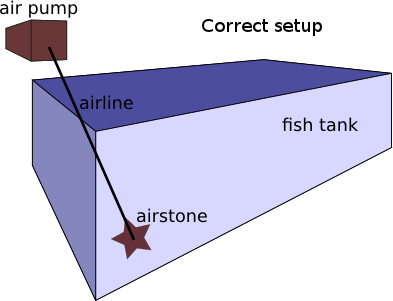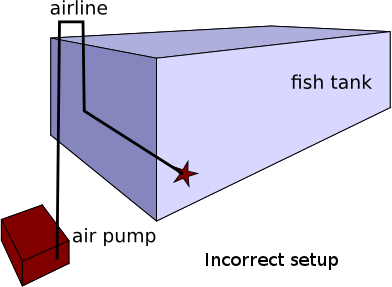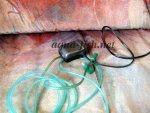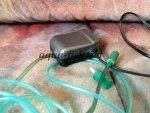Ultimate Guide to Aquarium Air Stones: Usage, Suppliers, and Product Images
Quick navigation – Answers
Brief Description
This page provides detailed information about aquarium air stones, including frequently asked questions and their answers. We also feature a list of online suppliers where you can purchase air stones. To view this list, simply click here. Additionally, you might find these related pages on aqua-fish.net helpful: Aquarium Air Pump: FAQs and Guide and Understanding Aquarium Filters: Purpose, FAQs, and More.
How to Use an Air Stone: Purpose and Operation
Air stones can be placed almost anywhere in your fish tank, with few limitations on their position or quantity. These devices connect to an air pump via an airline, allowing air to be drawn from outside through the pump and into the air stone. The pump's motor drives a propeller that pulls air in, which is then directed to the air stone. When the air stone is activated, it releases air into the water through its numerous small holes.
Although air stones do not directly aerate the water, they facilitate aeration by creating waves as air escapes from the stone. This makes them a valuable addition not only for aeration but also for aesthetic purposes. While air stones are not essential for aquarium operation, they enhance oxygen levels and provide visual interest.
Air stones do not need to run continuously; operating them for 10-12 hours a day is typically sufficient to maintain adequate oxygen levels. Many air pumps can be noisy and may need regular monitoring as they can vibrate on the surface. A good indicator of sufficient oxygen is observing your fish; if they are not gasping for air at the surface, the oxygen levels are likely adequate.
Ideally, position the air stone at the bottom of the tank near the substrate (but never bury the air stone in the substrate!!!). Air pumps should be placed outside the aquarium and above the water level to prevent backflow in case of a power outage. Even a slight dip below the water level can cause water to flow into the pump if the air stone is positioned too close to the pump.
As previously mentioned, an air stone requires an air pump to function. Many aquarists ask why their air stones aren’t producing bubbles, so here’s some essential information to help clarify:
- If the air stone or decoration is small, the air pump doesn’t need to be very powerful. In this case, bubbles will emerge from only a small area of the stone.
- Connecting a large air stone to a small pump will result in bubbles being produced only at the front of the stone.
- For optimal performance, use larger air stones with powerful air pumps. Large stones are effective at creating impressive bubble walls and should be placed towards the back of the tank.
- Powerful pumps are not ideal for small air stones. This combination often produces large bubbles that can create turbulence on the water surface, which some fish species may find stressful. Fish that build bubble nests, for example, need calm water to breed successfully. Additionally, consider the depth at which you install the air stone; bubbles may increase in size as they rise from deep areas to the surface.
- An air pump with multiple outlets can support several air stones. If you have such a pump, you’ll need multiple air stones to maximize its effectiveness.
- Air pump output is typically measured in liters (or gallons) per minute, while wattage is less significant. Pond pumps can deliver up to 50 liters (12 US gallons, 11 Imperial gallons) per minute, but for fish tanks, a satisfactory output is often around 2 liters (0.52 US gallons, 0.43 Imperial gallons) per minute.


Placement in a Fish Tank - Using Aquarium Ornaments for Aeration
The optimal placement for an air stone is typically at the bottom of the tank, ideally positioned in the background or behind plants. This placement does not apply to breeding tanks, where it is important to minimize surface disturbance. In such cases, position your air stone as close to the surface as possible. Regardless of whether you are breeding bubble-nest builders, egg layers, or livebearers, the water in a breeding tank should remain relatively still.
You can create bubble walls or use decorative ornaments designed for aeration, such as caves, shells, pirate chests, and sunken ships. These items often serve as more visually appealing alternatives to traditional air stones. However, ensure that the airline is connected to ornaments specifically designed for aeration, as using regular decorations might produce large, noisy bubbles that can disturb fish. Decorations intended for aeration are typically labeled as "aeration ornaments" or similar.
Most air stones need to be pre-soaked before they function effectively. Place them in a container of water for about 10 minutes before adding them to the tank to ensure they produce bubbles immediately.
Sizes and Shapes
Air stones are commonly available in various shapes, including rolls, globes, discs, and even cubes. Roll-shaped air stones come in a range of sizes and colors, from about 3 cm (1 inch) to over 1.5 meters (almost 5 feet) in length. Generally, longer air stones tend to be flexible and less durable. Additionally, pond aerators, which are often too large and powerful for use in a standard fish tank, should be avoided.
Why Is Water Aeration Necessary?
Just like humans, fish need oxygen to survive. While some species, such as Betta fish, Gouramis, and Plecos with primitive lungs, can breathe atmospheric air, most fish rely on adequate oxygen levels in their tank. Without sufficient oxygen, fish will stay near the surface where oxygen concentration is higher. To ensure proper aeration, fish keepers can use one or more of the following methods:
- Filtration – Creates water movement and surface agitation.
- Air Stones/Aerating Decorations – Enhances water movement and oxygen exchange.
- Open-Top Aquariums – Increases gas exchange with the environment.
It’s prudent to ensure reliable aeration, especially if you’re going on vacation. If a filter becomes clogged, an air stone will continue to provide sufficient water movement to maintain oxygen levels.
Additionally, many medications used to treat fish diseases can lower oxygen levels in the tank. Running an air stone during medication treatment helps maintain adequate oxygen levels for the health of your fish.
Pictures
Below are two images showing an aquarium air pump connected to air stones via a hose.
Questions and Answers
Visitors of aqua-fish.net are encouraged to submit their questions or share their experiences. We have gathered questions and provided answers at aqua-fish.net/answers, and these answers have now been integrated into our related articles. You’ll find responses to common questions below. Please note that some answers may have been partially covered in the article above or in comments posted prior to March 19th, 2011.
-
Why is an air stone necessary in an aquarium?
Answer: Air stones help maintain adequate oxygen levels in the aquarium water, which is essential for fish to breathe through their gills. Insufficient oxygen can lead to a condition similar to drowning in fish.
-
How do different sizes of air stones affect performance?
Answer: Larger air stones generate more bubbles and are suitable for powerful air pumps, while smaller air stones may not work effectively with strong air pumps. Conversely, a large air stone may be ineffective if paired with a low-output air pump.
-
When should air stones be used in aquariums?
Answer: Air stones are useful when filters are not sufficient to aerate the water effectively. They are also sometimes used for decorative purposes.
-
Why do air stones crumble over time?
Answer: Over time, air stones can disintegrate due to the continuous flow of air which dislodges particles from the stone. This wear and tear is a natural part of their lifespan.
-
Why does my new air stone only produce bubbles in one area?
Answer: New air stones may sometimes produce bubbles unevenly due to trapped dust or debris. Soaking the stone for about an hour before use can help prevent this issue.
-
What exactly is an air stone?
Answer: An air stone is a device connected to an air pump via plastic tubing. When submerged in an aquarium, it releases tiny bubbles that help to aerate and circulate the water.
-
How do I choose the right size air stone for my tank?
Answer: The size of the air stone affects the distribution of bubbles. A small air stone creates a single stream of bubbles, while larger stones can produce a curtain of bubbles across a broader area.
-
Where should an air stone be placed in an aquarium?
Answer: Attach the airline to the air stone and submerge it in the aquarium where you want to create bubbles. The other end of the airline should be connected to an air pump placed above the aquarium to prevent water from siphoning back into the pump. Using a check valve can provide extra protection against backflow.
Suppliers of Aquarium Air Stones
If any of the following links are not working, please let us know by using the form at the bottom of this page.






